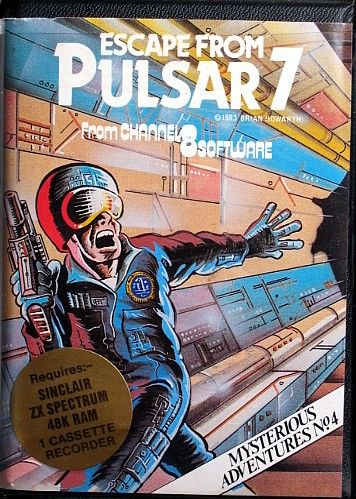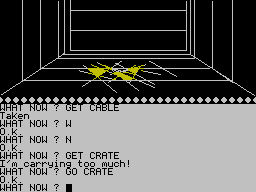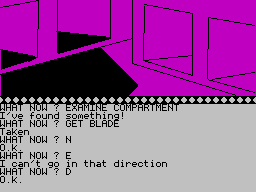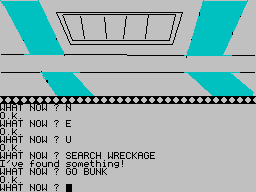Retro Replay Review
Gameplay
Escape from Pulsar 7 sticks closely to its Scott Adams engine roots, delivering a straightforward two-word parser that challenges you to think concisely. You’ll quickly learn to combine simple verbs like “GET” and “USE” with key nouns pulled from your immediate surroundings. This pared-down interaction model keeps the focus squarely on exploration and careful inventory management rather than on wrestling with an unwieldy parser.
The core objective—finding tools to launch the lifepod before the mutated zoo specimen finds you—drives a largely linear progression. While some players may find the lack of branching paths limiting, the tight sequencing of puzzles ensures every item you pick up serves a purpose. Maze sections pepper the journey, and mapping out ventilation shafts or maintenance corridors becomes an exercise in patience and attention to detail.
Puzzle difficulty hovers in the moderate range. Most challenges hinge on knowing exactly which object to deploy in each section of the ship, while a handful of navigation puzzles test your sense of direction. Hints are scarce, so be prepared to backtrack and experiment, especially when the tension ramps up as you hear the creature’s ominous approach in the text descriptions.
Graphics
Though Escape from Pulsar 7 bills itself as an “illustrated text adventure,” its visuals are modest by modern standards. Each location is accompanied by a small black-and-white bitmap that captures just enough detail to set the scene—whether it’s a blood-streaked bunk room or a flickering engine compartment. Far from photorealistic, these images nonetheless bolster the game’s tense atmosphere.
Fans of early 1980s adventures will appreciate the nostalgia factor. The illustrations echo other Scott Adams-style titles: simple line work, sparse shading, and an emphasis on form over flourish. While you won’t mistake these for contemporary pixel art, they complement the text nicely, breaking up long passages of description and giving you a quick visual anchor in each new environment.
Loading a new graphic before each major section adds a momentary pause that heightens suspense. You’ll find yourself lingering over each image, looking for hidden doors or ominous shadows that the text might not call out explicitly. In that sense, the minimal presentation becomes part of the game’s puzzle, rewarding a careful eye.
Story
Set against a backdrop heavily influenced by the film Alien, Escape from Pulsar 7 drops you into a derelict starship where a mutated zoo specimen has slaughtered the crew. You’re the lone survivor, and every shuffled footstep echoes down empty corridors. The premise is instantly gripping: outrun or outwit a relentless creature while piecing together the fate of your crewmates.
Narrative unfolds through terse location descriptions, overheard logs, and the occasional crew journal entry found in the bunks. Though the game doesn’t feature branching dialogue or character interactions, each discovery intensifies the sense of dread. You learn more about the creature’s origin and the ship’s doomed mission in snippets, and that fragmented storytelling keeps you guessing until the very end.
Despite its brevity, the plot maintains a steady pace. There’s no unnecessary padding—every corridor you navigate and every tool you retrieve feels integral to your escape. If you’re seeking a sprawling sci-fi epic, you may be disappointed by the short runtime. But as a focused, high-tension scenario, it delivers consistent thrills.
Overall Experience
Escape from Pulsar 7 offers a concise, atmospheric text-graphics hybrid that will appeal most to retro adventure aficionados. The streamlined parser and linear design keep the emphasis on methodical exploration and puzzle solving, while the dark, claustrophobic environments conjure a genuine sense of peril. Every creak of a bulkhead door and every flicker of your handheld lamp heightens the suspense.
That said, modern players accustomed to robust parsers or multiple narrative branches may find the format restrictive. The game’s short length and fairly predictable puzzle solutions mean it may not hold your attention for long—but those looking for a bite-sized, tension-filled diversion will find it hard to put down.
In the end, Escape from Pulsar 7 stands as a polished example of early illustrated text adventures. Its sparse graphics, lean storytelling, and methodical gameplay combine to create a memorable—and often nerve-wracking—escape puzzle. Recommended for anyone eager to revisit classic Scott Adams-style challenges or newcomers curious about the roots of interactive sci-fi drama.
 Retro Replay Retro Replay gaming reviews, news, emulation, geek stuff and more!
Retro Replay Retro Replay gaming reviews, news, emulation, geek stuff and more!









Reviews
There are no reviews yet.